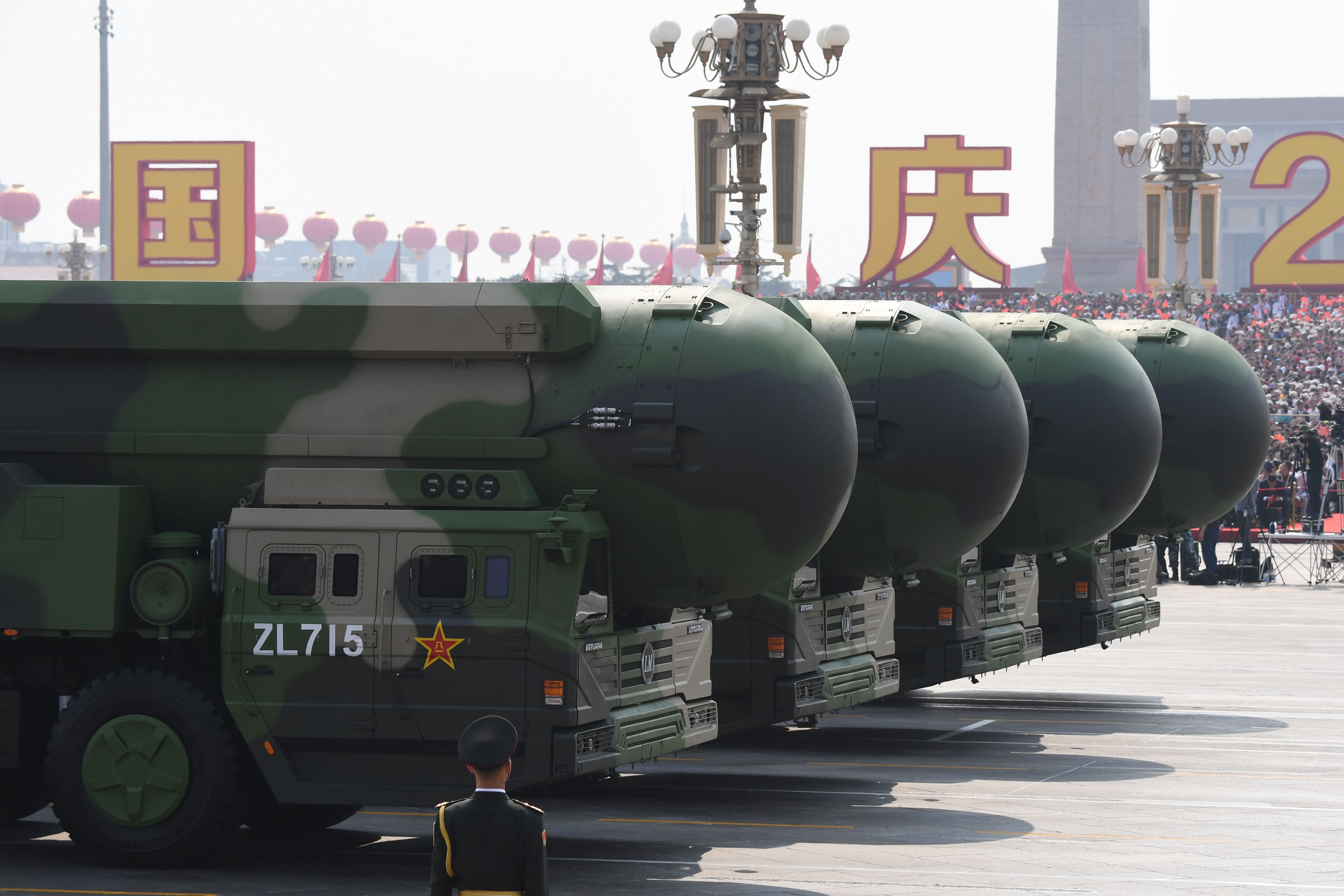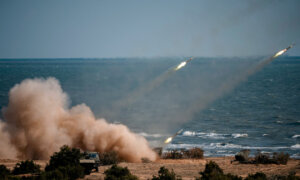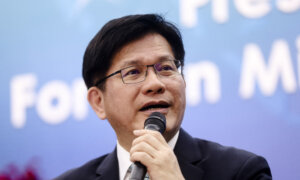News Analysis
Last month, the Chinese regime test-fired an intercontinental ballistic missile (ICBM) into the South Pacific for the first time in 44 years, raising concerns among nations in the region.
The rare test delivered a political message amid tensions in the western Pacific region, particularly in the South China Sea. It also had a pragmatic purpose, experts told The Epoch Times: evaluating the capabilities of the People’s Liberation Army Rocket Force (PLARF).
The missile, which carried a dummy warhead, was believed by analysts to be China’s newest ICBM, the Dong Feng-41 or an older ICBM, the Dong Feng-31AG. “Dong Feng” means “East Wind” in Chinese.
The DF-41 is China’s longest-range ICBM, capable of traveling 12,000 to 15,000 kilometers (7,500 to 9,500 miles). The DF-31AG has a shorter range of 7,000 to 11,700 km (4,300 miles to 7,300 miles).
Fired on Sept. 25 from an undisclosed location—widely believed to be a site on Hainan Island, which sits north of the South China Sea—the missile traveled approximately 12,000 km (7,456 miles) and landed near French Polynesia, a group of islands that includes Tahiti.
Beijing has called the launch a “routine arrangement” on the part of the PLARF. Other countries with long-range missiles, such as the United States, Russia, and India, routinely conduct such tests.
However, the Chinese military has not fired a long-range missile into the Pacific since 1980. In past years, China has tested its missiles inland, mostly in the remote deserts of northwest China.
It’s possible the reason for the site change is strictly technical, according to Denny Roy, senior fellow at the Honolulu-based East-West Center.
“Chinese engineers might have felt they needed to test fly a missile with a long, relatively flat trajectory, which is more similar to how they would use a long-range missile in combat, rather than [the] usual lofted trajectory to keep the flight within or near Chinese borders,” Roy told The Epoch Times in an email.
“Having said that, there are several possible intended political messages.”
Maritime tracking data viewed by Reuters showed that two of China’s most advanced “space support”—or missile tracking—ships, the Yuan-wang 3 and Yuan-wang 5, were in the Pacific at the time of the launch.
Beijing didn’t reveal where the missile had entered the water, but said it had “accurately landed in the predetermined sea area.”
Hsiao-Huang Shu, an associate research fellow at Taiwan’s Institute for National Defense and Security Research, told The Epoch Times that the transport of the ICBM, either by land or by sea, is an integral part of the exercise.
Both the DF-31AG and DF-41 are road-mobile ICBMs. They are more flexible and can be harder to detect and target than their silo-based counterparts, but the transportation of such heavy artillery also requires extra logistical planning to address issues such as road conditions and communications.
The PLARF, formerly known as the Second Artillery Force, is the branch of China’s military responsible for its land-based nuclear and conventional missile forces. Beijing has modernized the PLARF and expanded its role over the past 15 years, in concert with China’s “evolving strategy regarding deterrence,” according to a report from the U.S. Army.
“Any military planner involved in operations in the Asia-Pacific theater must have an understanding of this unique force as it presents a threat to its neighbors, specifically Taiwan, and maintains the ability to influence local, regional, and global military operations,” the report states.
Nuclear Blackmail
The test in September was launched after a series of corruption scandals led to doubts about the PLARF’s capabilities, and amid increased tensions between Beijing and its neighbors in the region. Its timing ahead of elections in the United States and Japan may also be significant, according to analysts.Besides the technical necessity of the test, analysts say Beijing’s test of an ICBM in the Pacific Ocean may carry a number of political messages to both domestic and foreign audiences. First and foremost, it was intended to discourage the United States from getting involved in conflicts in the Indo-Pacific, they said.
Beijing “sent a signal to its adversaries that ‘our missile has the capacity to threaten you,’” Shu said. “The signal is very clear.”
The signal “was meant for the United States and other nations in the region, but mostly the United States,” he said.
Following a series of encounters between Chinese and Philippine coast guard vessels and aircraft in and over the South China Sea, the United States reaffirmed its commitment to the U.S.–Philippines Mutual Defense Treaty.
As part of an annual military exercise, the U.S. army deployed its mid-range Typhon missile system to the northern Philippines in April, leading to repeated protests from the Chinese regime.
President Joe Biden has also signed off on military aid to Taiwan on top of regular arms sales, and has repeatedly said U.S forces would defend Taiwan in the event of a Chinese invasion—despite a long-standing U.S. policy of strategic ambiguity. U.S. officials have also sought to downplay the president’s comments each time.
In protest of U.S. weapons sales to Taiwan, Beijing in July rejected Washington’s call for more nuclear arms-control talks.
“There are several possible intended political messages” that Beijing was trying to send, such as, “‘Our strategic rocket forces still work. You’ll pay dearly if you try to defend Taiwan. We’re not happy about the U.S. Typhon missile system in the Philippines,’” Roy said.
Shihmin Chen, a specialist in arms control and Chinese military affairs, told The Epoch Times that Chinese leader Xi Jinping may be emulating President Vladimir Putin’s strategy of “nuclear blackmail.”
Putin has threatened nuclear escalation in a bid to deter the West from allowing Ukraine to fire long-range missiles it obtained from the West into Russia.
Chen said China’s nuclear saber-rattling may also be an attempt to sow doubt among U.S. allies about the United States as a “nuclear umbrella,” a source of protection for non-nuclear allied states in the event of an attack.
“Can they really trust the United States to risk the safety of Los Angeles in order to save Tokyo, Australia, or Taipei? Maybe Beijing wants to make these countries consider this and weaken their trust in the credibility of U.S. security guarantees as a nuclear umbrella,” Chen said.
Eroding trust could prompt more countries to develop their own nuclear capabilities, Chen said.
Balance of Terror
Beijing maintains a “no first-use” policy with regard to nuclear weapons and has urged other nuclear powers to make the same promises. However, analysts are skeptical of the Chinese regime’s willingness to stick to its own policy in a war scenario.Commenting on the fear that Beijing will threaten to use nuclear weapons in a potential conflict in the Indo-Pacific, Shu said the Chinese regime will also have to consider U.S. nuclear deterrence.
At present, China has a much smaller number of operational warheads than either Russia (which has about 4,380) or the United States (which has about 3,708).
However, the Chinese regime is in the midst of a rapid expansion of its nuclear arsenal.
In a 2020 report, the Department of Defense estimated that China’s arsenal would grow to about 200 warheads by 2025.
By May of 2023, however, it estimated that China already had more than 500 operational warheads. It projected that the number would double by 2030, with many of the warheads “deployed at higher readiness levels.”
An annual arms report published in June by the Stockholm International Peace Research Institute estimated that China could potentially have at least as many ICBMs as either Russia or the United States by 2030.
In addition, the regime’s deployment of the medium-range ballistic missile DF-17, which carries the DF-ZF hypersonic glide vehicle, is expected “to continue to transform the PLA’s missile force,” according to a 2023 Defense Department report.
However, the PLARF relies heavily on its 231 Xi'an H-6 bombers. Although the bombers have been continually improved and upgraded—for instance, to carry hypersonic anti-ship missiles—the fact remains that they are Soviet-era aircraft. Analysts say China’s reliance on the vintage aircraft indicates that it still has a way to go to achieve a credible nuclear triad.
Vipin Narang, who served as acting assistant secretary of defense for space policy until August, offered his views while speaking at the Center for Strategic and International Studies. Narang said that the U.S. president has issued updated nuclear weapons employment guidance due to an “unprecedented” situation in which multiple nuclear challengers are “rapidly modernizing and expanding their nuclear arsenals, and openly threatening to employ nuclear weapons to achieve their aims.”
Reuters contributed to this report.









